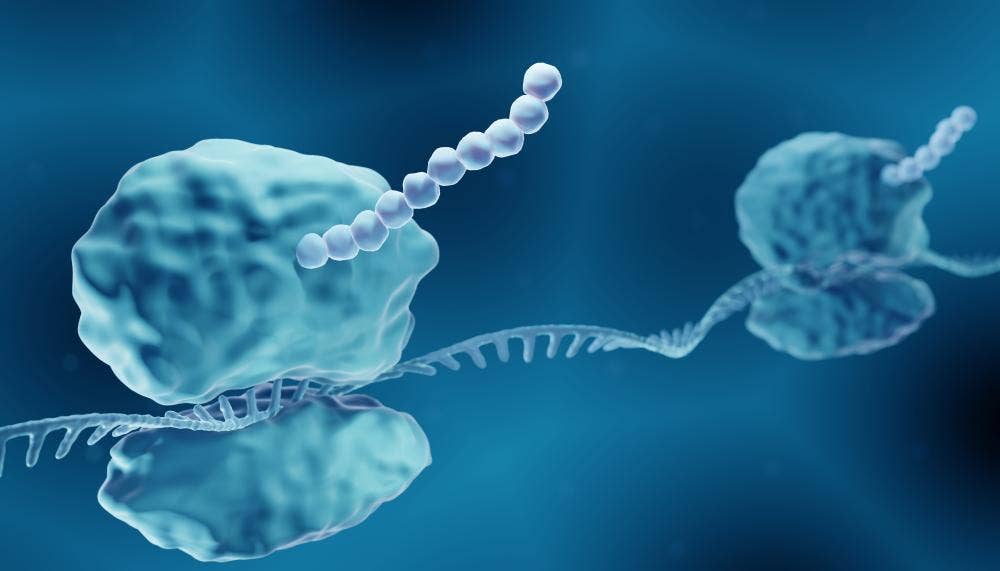Internal capping enhances protein production from circular mRNA
Circular mRNAs are becoming an attractive option for developing mRNA vaccines and therapeutics due to their stability and lower immunogenicity in cells. However, because circular mRNAs lack an N7-methylguanosine (m7G) cap, they require other mechanisms to drive protein synthesis, such as an internal ribosome entry site (IRES) sequence, which has an intrinsically low translation efficiency. To address this issue, researchers at Nagoya University, Japan, have developed molecular strategies to place an m7G cap internally on circular RNAs. Their data, published in Nature Biotechnology, show internal capping to enhance protein expression levels and mitigate immune stimulation in mice, providing a straightforward and adaptable approach to extend the biomedical application of circular mRNA.

Covalent insertion of an m7G cap increases protein synthesis efficiency
To check the feasibility of internal cap-initiated translation (ICIT), Fukuchi et al. covalently inserted an m7G cap into circular mRNA (cap-circ mRNA) by ligating two RNA fragments: a chemically synthesized 54-nt capped branched RNA strand and an in vitro transcribed (IVT) 550-nt RNA strand containing the coding sequence of NanoLuc luciferase (Nluc).
Various circular mRNAs were generated, including constructs with an uncapped branched strand, constructs differing in the position of the branch structure, and constructs featuring N1-methylpseudouridine (m1Ψ) modification, as well as circular mRNAs containing an IRES. In addition, linear control mRNAs were prepared by IVT using T7 RNA polymerase with TriLink’s CleanCap® Reagent AG.
In vitro translation activity was assessed by measuring Nluc expression in transfected HeLa cells. Key findings included the observation that circular mRNAs with a capped branched strand exhibited up to a 189-fold increase in Nluc expression compared to their uncapped counterparts. It was also found that m1Ψ modification further increased the protein synthesis efficiency of cap-circ mRNA, but greatly attenuated IRES-driven translation. Additionally, Nluc production was shown to be more incremental for cap-circ mRNA than the linear control, which was confirmed by RT-qPCR to be due to the higher stability of cap-circ mRNA.
Internal capping mitigates immune stimulation in mice
The acute immune response to cap-circ mRNA was evaluated by measuring the plasma levels of two pro-inflammatory cytokines, IL-6 and IFN-γ, using ELISA, at 6h and 24h after intravenous administration to Balb/c mice. Animals that received m1Ψ-modified cap-circ and linear mRNAs showed a suppressed innate immune response, while those that received a construct lacking the m1Ψ modification had significantly increased IL-6 and IFN-γ levels.
Non-covalent attachment of an m7G cap enhances translation
To determine whether non-covalent tethering of the m7G cap to circular mRNAs could also promote translation, based on the hypothesis that translation activity might depend on the position of the branched strand toward the start codon, Fukuchi et al. synthesized a series of m7G capped oligoribonucleotides (cORNs) complementary to circular mRNA encoding Nluc. Testing in cultured HeLa cells showed this method to enhance translation from the circular mRNA by more than 50-fold. Non-covalent attachment of the m7G cap also facilitated rolling circle-type translation of circular mRNA, increasing the production efficiency of large proteins.
In vivo translation activity is improved by internal capping
The in vivo translation activity of cap-circ mRNA was investigated using a construct encoding a HiBiT peptide and a capped linear control, which were formulated into lipid nanoparticles (LNPs) for intravenous delivery to Balb/c mice. Testing with a HiBiT lytic assay showed the expression level of the linear mRNA to be higher immediately after administration than that of the cap-circ mRNA. However, 48 hours after administration, the amount of expressed peptide from cap-circ mRNA was 14 times greater in the liver and 12 times greater in the spleen compared to the linear mRNA. This slower, more durable expression of cap-circ mRNA was comparable to the behavior seen in cultured HeLa cells, confirming that the m7G cap enables persistent protein synthesis.
Conclusion
This study shows that internal capping of circular mRNAs increases translation efficiency and sustains protein synthesis, both in cultured cells and in vivo, broadening the therapeutic utility of circular mRNA molecules.
Featured products: CleanCap® mRNA Capping Reagents, CleanCap® Reagent AG
Related products: IVT enzymes, oligonucleotide synthesis services, N1-Methylpseudouridine-5'-Triphosphate
Article reference: Fukuchi K, Nakashima Y, Abe N, et al. Internal cap-initiated translation for efficient protein production from circular mRNA. Nat Biotechnol (2025). https://www.nature.com/articles/s41587-025-02561-8


